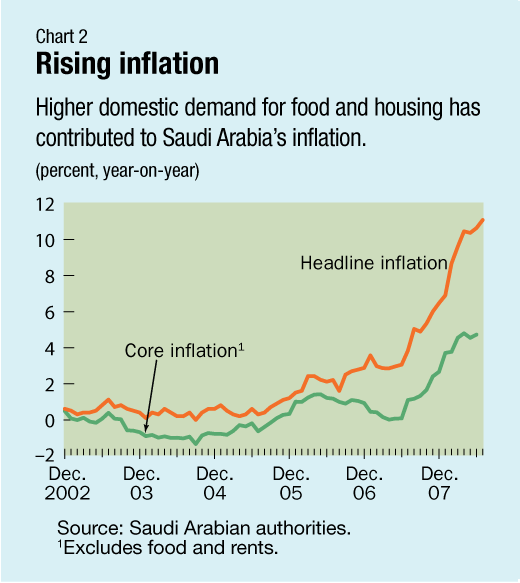Middle East

Typical street scene in Santa Ana, El Salvador. (Photo: iStock)
IMF Survey: Saudi Arabia: Managing the Oil Bonanza
September 19, 2008
- Saudi Arabia's surging oil revenues have led to large fiscal and external surpluses
- Inflation has emerged as a policy challenge
- More structural reforms needed to boost job creation, diversify the economy
Saudi Arabia is experiencing robust growth, thanks to high oil prices and strong private sector investment. But surging oil revenues also present complex challenges, including how to share the wealth from nonrenewable oil resources with future generations.

A man withdraws cash at an ATM in Saudi Arabia, where the financial services sector is expanding rapidly (photo: Barry Lewis/Corbis)
Saudi Arabia has achieved strong growth since the recent oil boom started in 2003. The economy grew by an average of 4.3 percent during 2003-07, driven by a continued rapid expansion in the non-oil private sector (in particular, financial and construction services).
Non-oil private growth has averaged 5.4 percent during 2003-07 (see Chart 1), leading to substantial job creation, including for foreign workers mainly from low-income countries in the region and Asia, who sent home $16 billion in remittances in 2007. However, unemployment among the young remains high, reflecting skill mismatches and high reservation wages.

Key oil role
Saudi Arabia continues to play a key role in the stability of the international oil market, accounting for 22 percent of global oil reserves and around two-thirds of global spare production capacity (2 million barrels per day (mbd)).
Investments of around $90 billion over the next few years will boost crude production output to 12.5 mbd by 2009 and increase refining capacity. After hosting a summit of industry experts and representatives from oil-producing and oil-consuming countries in June 2008, the Saudis decided to boost oil production to 9.7 mbd in July 2008 to contain volatility in global oil markets.
Complex challenges
Surging oil revenues have provided a complex set of challenges. On the one hand, Saudi Arabia has major development needs in infrastructure and social services, and fiscal spending aimed to improve education, housing, transportation, and other infrastructure has been stepped up in recent years (much of it managed through public-private partnerships). This has boosted imports and, in line with policy plans discussed under the Multilateral Consultation on Global Imbalances, helped contain global imbalances.
On the other hand, since oil is a nonrenewable resource, part of the oil wealth should be preserved for future generations through the accumulation of external financial assets—i.e., a current account surplus. Indeed, a significant portion of oil revenues is being used to accumulate net foreign assets at the central bank, which at end-2007 stood at $301 billion (the equivalent of 19 months of imports), and, to a lesser extent, in pension and state investment funds. These reserves also provide a safety cushion in the event of adverse developments to oil prices.
Inflation emerges
After several years of very low inflation rates, inflation has recently emerged as a major short-term challenge, similar to other countries in the area, accelerating to a 30-year high of 11.1 percent year over year in July 2008 (see Chart 2).
Domestic demand pressures arising from higher income and wealth, supply constraints (housing), and imported inflation (food) have been the main factors. Given the peg to the dollar, Saudi Arabia was also importing the easing monetary stance of the United States since mid-2007, further fueling inflation.
The authorities remain committed to the peg, which has served successfully for decades as a nominal anchor and was reaffirmed in 2003 as a stepping stone toward monetary union among the members of the Gulf Cooperation Council.

With monetary policy tied up by the peg to the dollar, fiscal policy remains the main demand management tool—but the Saudi authorities face difficult trade-offs between restraining spending to curb inflation and increasing capital outlays to address infrastructure bottlenecks that are driving inflation on the supply side.
The authorities have sought to cope with the impact of inflation through several structural measures, including the passage of a mortgage law to facilitate housing development, a 15 percent wage increase over three years, subsidies on food, reduced import tariffs, and the waiving of several administrative fees.
To curb credit growth, the central bank increased reserve requirements in four steps by a cumulative 600 basis points and issued bills to mop up liquidity. Inflation is expected to gradually subside starting in late 2008 as global commodity prices ease, U.S. monetary policy firms, and supply bottlenecks are overcome, with infrastructure and housing investments coming on stream.
Consolidating recent gains
Saudi Arabia's medium-term outlook remains very favorable, with growth being sustained by strong private sector investment and government spending on key infrastructure. Large fiscal and external surpluses are projected to continue, given high oil prices. Even sharply lower oil prices would be unlikely to endanger macroeconomic stability—the oil price that would balance the current account in 2013 is estimated at around $70 per barrel. Nonetheless, the fiscal framework could be further strengthened by anchoring budgets in a medium-term setting and by managing the oil wealth with an explicit long-term, intergenerational perspective.
Policymakers have long understood the importance of structural reforms to boost job creation and diversify the economy, which is now compounded by the need to address supply constraints that contribute to inflation. As an outcome of the sweeping structural reforms already undertaken, the International Finance Corporation's Doing Business report ranked Saudi Arabia first among Arab countries for three consecutive years and twenty-third globally in 2008.
But in order to consolidate these gains and further diversify the economy, the authorities will need to implement vigorously the planned second-generation reforms critical to private sector development and employment creation, notably improvements in education, financial sector deepening, contract enforcement, and the modernization of the legal system.
Comments on this article should be sent to imfsurvey@imf.org







